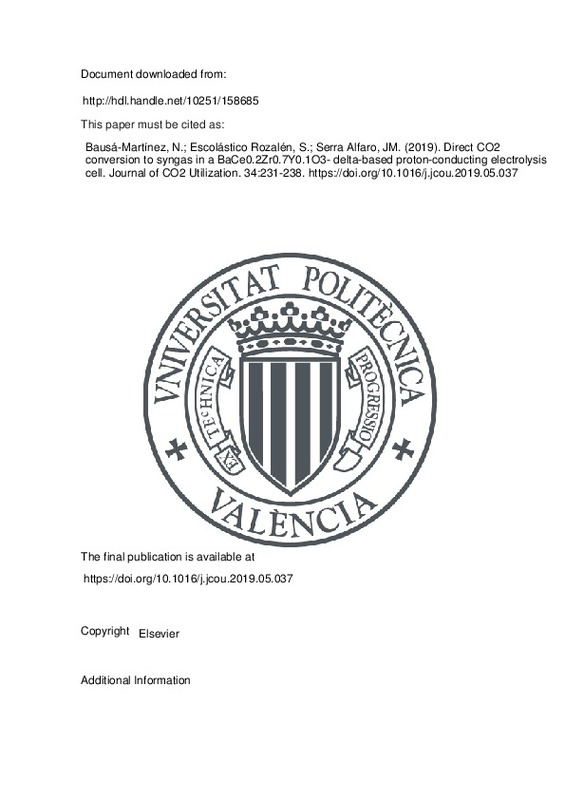JavaScript is disabled for your browser. Some features of this site may not work without it.
Buscar en RiuNet
Listar
Mi cuenta
Estadísticas
Ayuda RiuNet
Admin. UPV
Direct CO2 conversion to syngas in a BaCe0.2Zr0.7Y0.1O3- delta-based proton-conducting electrolysis cell
Mostrar el registro sencillo del ítem
Ficheros en el ítem
| dc.contributor.author | Bausá-Martínez, Nuria
|
es_ES |
| dc.contributor.author | Escolástico Rozalén, Sonia
|
es_ES |
| dc.contributor.author | Serra Alfaro, José Manuel
|
es_ES |
| dc.date.accessioned | 2021-01-12T04:32:06Z | |
| dc.date.available | 2021-01-12T04:32:06Z | |
| dc.date.issued | 2019-12 | es_ES |
| dc.identifier.issn | 2212-9820 | es_ES |
| dc.identifier.uri | http://hdl.handle.net/10251/158685 | |
| dc.description.abstract | [EN] Electrolysis of steam and CO2 is considered to be a promising instrument for energy storage via sustainable H-2 and hydrocarbon production. A model electrolysis cell was assembled using a thick BaCe0.2Zr0.7Y0.1O3-delta (BCZY27) electrolyte and two distinct electrodes, i.e., a (H-2-cathode) porous Pt layer; and (steam-anode) a composite made of 60 vol. % La0.8Sr0.2MnO3-delta (LSM) and 40 vol. % BCZY27. The as-sintered steam electrode was catalytically-activated with Pr6O11-CeO2 nanoparticles. The cell was characterized by means of voltamperometry and impedance spectroscopy. Different operation parameters were analyzed: temperature; water concentration in the anode chamber; and H-2 and CO2 concentration in the cathode chamber. Increasing H2O concentration (in the anode) and presence of CO2 (in the cathode) positively affected the electrode performance giving rise to lower cell overpotential and, consequently, substantial improvement in Faradaic efficiency. The high electrolyte thickness and the non-optimized Pt cathode limited the range of current density and the achieved peak power densities. The Faradaic efficiency for water electrolysis reached a value of 39% at 10.4 mA/cm(2), as determined by the analysis of the H-2 production. During co-electrolysis, the CO2 reaction was fostered by co-feeding a minimum H-2 amount. CO formation took place through the reverse water gas shift (RWGS) reaction. When the current density was applied, CO2 conversion increased due mainly to the non-Faradaic electrochemical modification of catalytic activity (NEMCA effect) that allowed for the improvement of CO2 hydrogenation kinetics. | es_ES |
| dc.description.sponsorship | Financial support by the Spanish Government (SEV-2016-0683, Project ENE2014-57651 and IJCI-2016-28330 grants) and by the EU through FP7 Electra Project (Grant Agreement 621244) is gratefully acknowledged. The support of the microscopy service at Universitat Politecnica de Valencia (UPV) for the SEM analysis is recognized. | es_ES |
| dc.language | Inglés | es_ES |
| dc.publisher | Elsevier | es_ES |
| dc.relation.ispartof | Journal of CO2 Utilization | es_ES |
| dc.rights | Reconocimiento - No comercial - Sin obra derivada (by-nc-nd) | es_ES |
| dc.subject | Proton ceramic electrolyzer cell (PCEC) | es_ES |
| dc.subject | Electrolysis | es_ES |
| dc.subject | Co-electrolysis | es_ES |
| dc.subject | BCZY | es_ES |
| dc.subject | Catalytic nanoparticles | es_ES |
| dc.subject | CO2 | es_ES |
| dc.title | Direct CO2 conversion to syngas in a BaCe0.2Zr0.7Y0.1O3- delta-based proton-conducting electrolysis cell | es_ES |
| dc.type | Artículo | es_ES |
| dc.identifier.doi | 10.1016/j.jcou.2019.05.037 | es_ES |
| dc.relation.projectID | info:eu-repo/grantAgreement/MINECO//IJCI-2016-28330/ | es_ES |
| dc.relation.projectID | info:eu-repo/grantAgreement/EC/FP7/621244/EU/High temperature electrolyser with novel proton ceramic tubular modules of superior efficiency, robustness, and lifetime economy/ | |
| dc.relation.projectID | info:eu-repo/grantAgreement/MINECO//ENE2014-57651-R/ES/ALMACENAMIENTO DE ENERGIA VIA REDUCCION DE CO2 A COMBUSTIBLES Y PRODUCTOS QUIMICOS/ | es_ES |
| dc.relation.projectID | info:eu-repo/grantAgreement/MINECO//SEV-2016-0683/ | es_ES |
| dc.rights.accessRights | Abierto | es_ES |
| dc.contributor.affiliation | Universitat Politècnica de València. Instituto Universitario Mixto de Tecnología Química - Institut Universitari Mixt de Tecnologia Química | es_ES |
| dc.description.bibliographicCitation | Bausá-Martínez, N.; Escolástico Rozalén, S.; Serra Alfaro, JM. (2019). Direct CO2 conversion to syngas in a BaCe0.2Zr0.7Y0.1O3- delta-based proton-conducting electrolysis cell. Journal of CO2 Utilization. 34:231-238. https://doi.org/10.1016/j.jcou.2019.05.037 | es_ES |
| dc.description.accrualMethod | S | es_ES |
| dc.relation.publisherversion | https://doi.org/10.1016/j.jcou.2019.05.037 | es_ES |
| dc.description.upvformatpinicio | 231 | es_ES |
| dc.description.upvformatpfin | 238 | es_ES |
| dc.type.version | info:eu-repo/semantics/publishedVersion | es_ES |
| dc.description.volume | 34 | es_ES |
| dc.relation.pasarela | S\390600 | es_ES |
| dc.contributor.funder | European Commission | es_ES |
| dc.contributor.funder | Ministerio de Economía y Competitividad | es_ES |







![[Cerrado]](/themes/UPV/images/candado.png)

